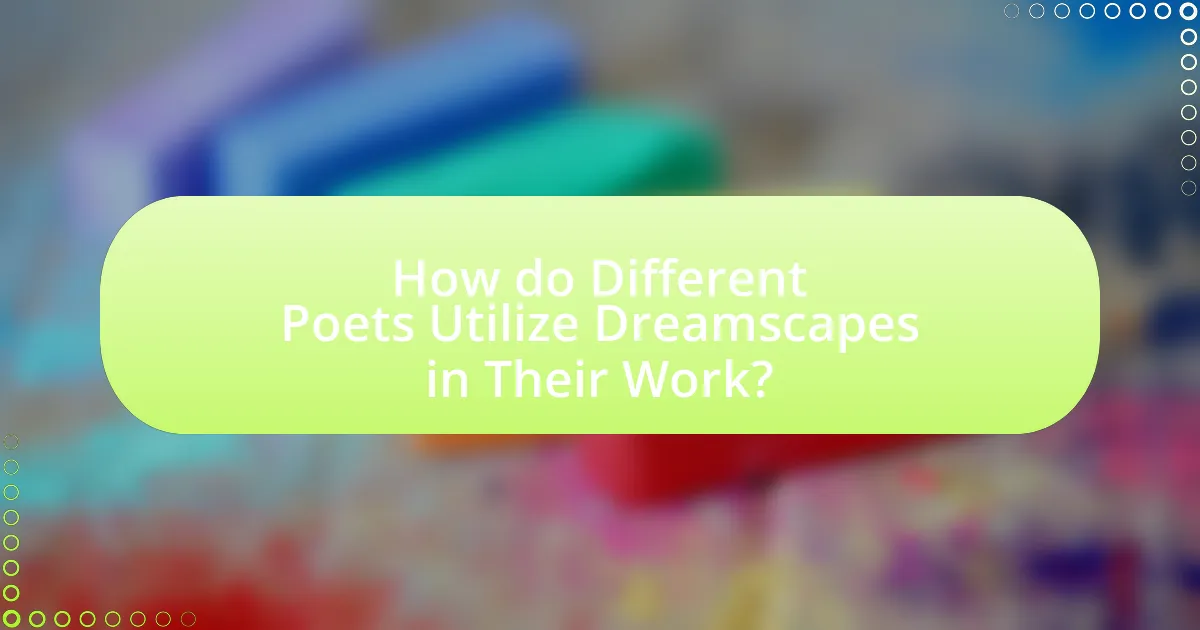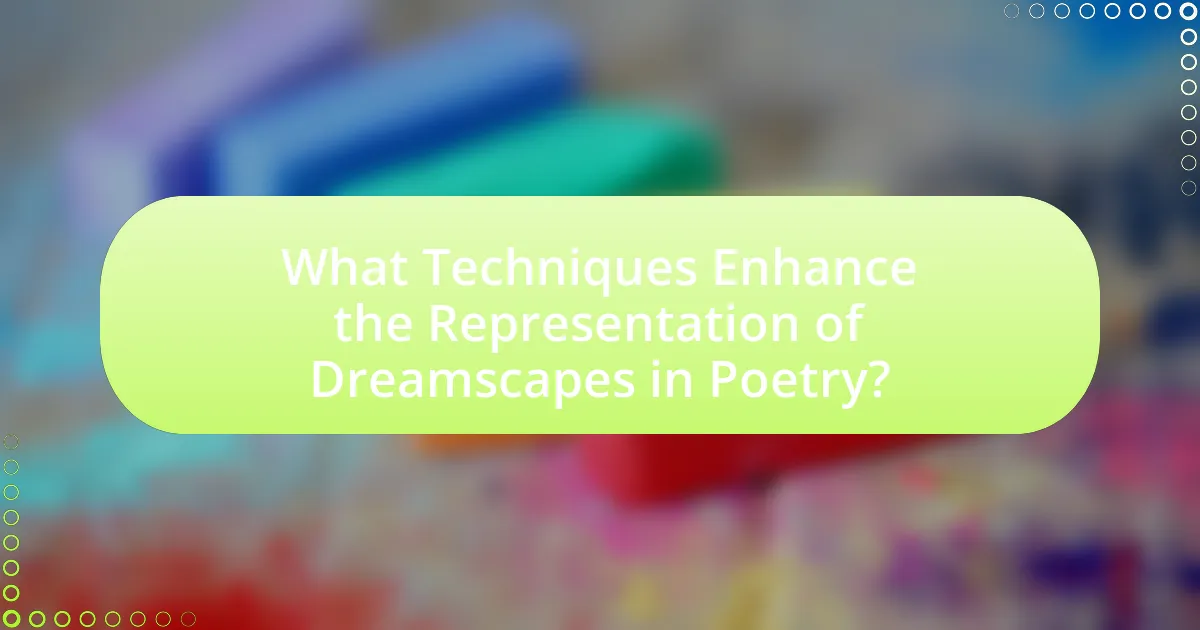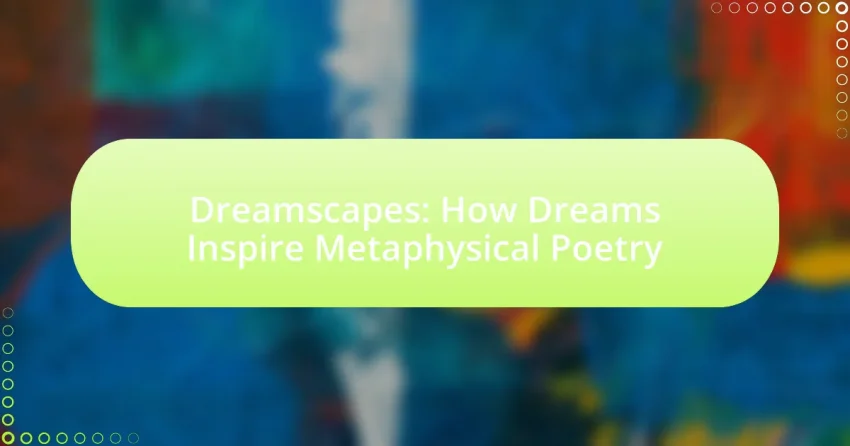Dreamscapes are imaginative landscapes derived from dreams, playing a crucial role in metaphysical poetry by allowing poets to explore complex themes such as existence, love, and reality. This article examines how poets like John Donne, Samuel Taylor Coleridge, and W.B. Yeats utilize dream imagery to enhance their exploration of metaphysical concepts, employing techniques such as vivid imagery, symbolism, and surrealism. It also discusses the influence of dreams on the creative process, the significance of dreams in addressing existential questions, and the modern approaches contemporary poets take in interpreting dreams within their work. Additionally, practical tips for poets on drawing inspiration from dreams are provided, emphasizing the importance of maintaining a dream journal and employing various literary techniques to translate dream experiences into poetry.

What are Dreamscapes and Their Role in Metaphysical Poetry?
Dreamscapes are imaginative landscapes that emerge from dreams, often characterized by surreal and abstract elements. In metaphysical poetry, dreamscapes serve as a vehicle for exploring complex themes such as existence, love, and the nature of reality. Poets like John Donne and Andrew Marvell utilize dream imagery to transcend ordinary experiences, allowing readers to engage with philosophical inquiries and emotional depth. The use of dreamscapes in this genre enhances the exploration of metaphysical concepts by creating a space where the boundaries between reality and imagination blur, facilitating profound reflections on the human condition.
How do dreams influence the creative process in poetry?
Dreams significantly influence the creative process in poetry by providing unique imagery, emotions, and narratives that poets can draw upon. The subconscious mind often generates surreal and vivid scenarios during dreams, which can inspire poets to explore themes of existence, identity, and the metaphysical. For instance, the works of poets like Samuel Taylor Coleridge and W.B. Yeats demonstrate how dream imagery can lead to profound poetic expressions, as Coleridge’s “Kubla Khan” was inspired by a dream vision. This connection between dreams and poetry is supported by psychological studies, such as those by Sigmund Freud, who emphasized the role of dreams in revealing hidden thoughts and emotions, thus enriching the poet’s creative landscape.
What elements of dreams are commonly reflected in metaphysical poetry?
Metaphysical poetry commonly reflects elements of dreams such as surreal imagery, emotional intensity, and the exploration of consciousness. Surreal imagery in metaphysical poetry often mirrors the bizarre and illogical nature of dreams, allowing poets to convey complex ideas through vivid and unexpected metaphors. Emotional intensity is another key element, as dreams frequently evoke strong feelings, which poets capture to express the depth of human experience. Additionally, the exploration of consciousness in dreams aligns with metaphysical poetry’s focus on the nature of reality and existence, prompting reflections on the self and the universe. These elements collectively illustrate how metaphysical poets utilize dream-like qualities to delve into philosophical themes and emotional truths.
How do poets interpret their dreams into poetic form?
Poets interpret their dreams into poetic form by translating the abstract and often surreal imagery of dreams into structured language that conveys emotion and meaning. This process involves capturing the essence of dream experiences, which may include vivid imagery, emotional resonance, and fragmented narratives, and then employing literary devices such as metaphor, symbolism, and rhythm to articulate these elements in a cohesive manner. For instance, poets like Samuel Taylor Coleridge and John Keats have utilized dream imagery to explore themes of beauty and the subconscious, demonstrating how dreams can serve as a rich source of inspiration for metaphysical poetry.
Why are dreams significant in the context of metaphysical themes?
Dreams are significant in the context of metaphysical themes because they serve as a bridge between the conscious and unconscious mind, allowing exploration of existential questions and the nature of reality. This exploration is evident in metaphysical poetry, where dreams often symbolize deeper truths and philosophical inquiries about existence, identity, and the universe. For instance, poets like John Donne and Andrew Marvell utilized dream imagery to delve into themes of love, mortality, and the divine, illustrating how dreams can reflect complex metaphysical ideas. The significance of dreams in this context is further supported by psychological theories, such as those proposed by Carl Jung, who emphasized that dreams reveal insights into the collective unconscious and archetypal symbols, reinforcing their role in understanding metaphysical concepts.
What metaphysical concepts are often explored through dreams?
Metaphysical concepts often explored through dreams include the nature of reality, the self, and the interconnectedness of existence. Dreams serve as a medium for individuals to confront existential questions, such as the distinction between the material and spiritual realms. For instance, philosophers like René Descartes have posited that dreams can blur the lines between reality and illusion, prompting deeper inquiry into consciousness and perception. Additionally, Carl Jung’s theories suggest that dreams reveal the unconscious mind, allowing exploration of archetypes and collective experiences that shape human understanding of existence. These explorations highlight how dreams can serve as a gateway to profound metaphysical insights.
How do dreams challenge the boundaries of reality in poetry?
Dreams challenge the boundaries of reality in poetry by allowing poets to explore surreal landscapes and emotions that defy logical constraints. This exploration often leads to the creation of vivid imagery and unconventional narratives that reflect the subconscious mind, as seen in the works of poets like Samuel Taylor Coleridge and his poem “Kubla Khan,” where dream-like visions create a fantastical realm. Such poetic expressions reveal deeper truths about human experience, illustrating how dreams can transcend ordinary perceptions and provoke profound insights into existence.

How do Different Poets Utilize Dreamscapes in Their Work?
Different poets utilize dreamscapes as a means to explore the subconscious, convey complex emotions, and create surreal imagery. For instance, Samuel Taylor Coleridge employs dreamlike elements in “Kubla Khan” to evoke a sense of wonder and mystery, illustrating the power of imagination and the ethereal nature of dreams. Similarly, W.B. Yeats incorporates dreamscapes in his poetry to reflect on personal and collective experiences, often blurring the lines between reality and fantasy, as seen in “The Song of Wandering Aengus.” These poets leverage dreamscapes to transcend ordinary experiences, allowing readers to engage with deeper philosophical and emotional themes.
What are some notable examples of poets who incorporate dreams?
Notable examples of poets who incorporate dreams include Samuel Taylor Coleridge, who famously explored dream imagery in works like “Kubla Khan,” and John Keats, whose poem “Sleep and Poetry” reflects on the relationship between dreams and creativity. Additionally, W.B. Yeats often infused his poetry with dream symbolism, as seen in “The Song of Wandering Aengus.” These poets utilize dreams to delve into the subconscious, illustrating the profound impact of dream states on their artistic expression.
How does John Donne’s poetry reflect his dream experiences?
John Donne’s poetry reflects his dream experiences through vivid imagery and complex metaphors that explore the nature of love, mortality, and spirituality. His poem “The Dream” exemplifies this, as it presents a dreamlike narrative where the speaker encounters a vision of his beloved, blurring the lines between reality and fantasy. This blending of dream and waking life illustrates Donne’s fascination with the subconscious and its influence on human emotions and relationships. Additionally, his use of paradox and wit in poems like “A Valediction: Forbidding Mourning” further emphasizes the dreamlike quality of love, suggesting that emotional connections transcend physical separation. These elements demonstrate how Donne’s exploration of dreams serves as a vehicle for deeper philosophical inquiries, making his work a significant contribution to metaphysical poetry.
In what ways does Samuel Taylor Coleridge use dreams in his metaphysical themes?
Samuel Taylor Coleridge employs dreams as a vehicle for exploring metaphysical themes by illustrating the interplay between reality and the imagination. In works such as “Kubla Khan,” Coleridge uses dream imagery to convey transcendent experiences and the nature of creativity, suggesting that dreams can reveal deeper truths about existence. Additionally, in “The Rime of the Ancient Mariner,” the dream-like narrative structure allows for an exploration of the subconscious and moral dilemmas, emphasizing the connection between the dream state and spiritual awakening. These examples demonstrate how Coleridge integrates dreams into his metaphysical inquiries, reflecting on the boundaries of human perception and the quest for understanding beyond the tangible world.
How do contemporary poets approach the theme of dreams?
Contemporary poets approach the theme of dreams as a multifaceted exploration of consciousness, identity, and the subconscious mind. They often utilize dreams as a metaphorical landscape to delve into personal and collective experiences, reflecting on the fluidity of reality and the complexities of human emotions. For instance, poets like Ocean Vuong and Mary Oliver incorporate dream imagery to evoke feelings of nostalgia and existential inquiry, illustrating how dreams can serve as a bridge between the inner self and the external world. This approach is supported by the increasing interest in psychological and philosophical interpretations of dreams, as seen in literary critiques and analyses that highlight the significance of dream symbolism in contemporary poetry.
What modern techniques are used to convey dream imagery in poetry?
Modern techniques used to convey dream imagery in poetry include surrealism, stream of consciousness, and vivid sensory details. Surrealism allows poets to create dream-like scenarios that defy logic, often employing unexpected juxtapositions and fantastical elements to evoke the subconscious mind. Stream of consciousness technique captures the fluid and often chaotic nature of thoughts and dreams, reflecting the inner workings of the mind without strict narrative structure. Vivid sensory details enhance the imagery by engaging multiple senses, making the dream experience more immersive and tangible for the reader. These techniques are effective in illustrating the complexities of dreams and their emotional resonance, as seen in the works of contemporary poets like Anne Carson and Ocean Vuong, who utilize these methods to explore themes of identity and memory.
How do contemporary poets differ from their predecessors in their use of dreams?
Contemporary poets differ from their predecessors in their use of dreams by incorporating a more fragmented and subjective approach, reflecting modern psychological theories and personal experiences. While earlier poets often utilized dreams as a means to explore universal themes or collective unconsciousness, contemporary poets tend to focus on individual narratives and the complexities of personal identity, influenced by postmodernism and existentialism. For instance, poets like Anne Carson and Ocean Vuong employ dream imagery to convey emotional depth and personal trauma, diverging from the more archetypal dream symbolism found in the works of poets like William Blake or Samuel Taylor Coleridge. This shift highlights a broader cultural movement towards introspection and the exploration of the self in the context of dreams.

What Techniques Enhance the Representation of Dreamscapes in Poetry?
Imagery, symbolism, and surrealism are key techniques that enhance the representation of dreamscapes in poetry. Imagery allows poets to create vivid mental pictures that evoke the sensory experiences of dreams, making the abstract more tangible. Symbolism adds layers of meaning, where objects or actions represent deeper concepts, reflecting the complexity of dream interpretation. Surrealism, characterized by illogical scenes and bizarre imagery, captures the essence of dreams by breaking conventional narrative structures, thus mirroring the unpredictable nature of the subconscious. These techniques collectively contribute to a rich, immersive experience that resonates with the dreamlike quality of metaphysical poetry.
How do literary devices contribute to the portrayal of dreams?
Literary devices significantly enhance the portrayal of dreams by creating vivid imagery, evoking emotions, and establishing thematic depth. For instance, metaphors and similes allow writers to draw comparisons between the dream state and reality, making abstract concepts more relatable. In metaphysical poetry, devices like symbolism and alliteration contribute to the surreal quality of dreams, emphasizing their complexity and often paradoxical nature. The use of enjambment can mirror the fluidity of dreams, allowing thoughts to flow seamlessly, reflecting the often disjointed experience of dreaming. These techniques collectively deepen the reader’s understanding of dreams as multifaceted experiences, illustrating their emotional and philosophical significance.
What role does symbolism play in dream-related poetry?
Symbolism serves as a crucial mechanism in dream-related poetry, enabling poets to convey complex emotions and abstract concepts through vivid imagery. In this genre, symbols often represent the subconscious mind, personal experiences, and universal themes, allowing readers to interpret deeper meanings beyond the literal text. For instance, a recurring motif of water may symbolize the fluidity of dreams or the depths of the unconscious, as seen in the works of poets like Samuel Taylor Coleridge, who utilized dream imagery to explore the human psyche. This use of symbolism not only enriches the poetic narrative but also invites multiple interpretations, making the exploration of dreams a multifaceted experience for the reader.
How do metaphors and similes enhance the dream experience in poetry?
Metaphors and similes enhance the dream experience in poetry by creating vivid imagery and emotional resonance that evoke the surreal nature of dreams. These literary devices allow poets to draw comparisons between disparate elements, enabling readers to visualize abstract concepts and feelings associated with dreams. For instance, a metaphor might describe a dream as a “shattered mirror,” suggesting fragmentation and disorientation, while a simile could compare the fleeting nature of dreams to “clouds drifting in the sky,” emphasizing their ephemeral quality. Such comparisons deepen the reader’s engagement and understanding of the dream state, making the experience more immersive and relatable.
What structural elements are important in dream-inspired poetry?
Important structural elements in dream-inspired poetry include free verse, vivid imagery, and nonlinear narrative. Free verse allows poets to break traditional constraints, reflecting the fluidity of dreams. Vivid imagery evokes sensory experiences, immersing readers in the dreamlike quality of the poem. Nonlinear narrative structures mirror the often disjointed and surreal nature of dreams, enabling a more authentic representation of the dream experience. These elements collectively enhance the emotional and imaginative impact of the poetry, aligning with the thematic exploration of dreams in metaphysical contexts.
How does the use of free verse affect the expression of dreamscapes?
The use of free verse enhances the expression of dreamscapes by allowing poets to break free from traditional structures, thereby capturing the fluidity and unpredictability of dreams. This form of poetry enables the incorporation of varied rhythms, line lengths, and enjambment, which mirror the often disjointed and surreal nature of dream experiences. For instance, poets like Walt Whitman and Allen Ginsberg utilized free verse to convey complex emotional landscapes and vivid imagery, reflecting the chaotic essence of dreams. The absence of a fixed meter or rhyme scheme facilitates a more organic flow of thoughts and images, aligning closely with the subconscious mind’s workings, which is essential for depicting dreamscapes effectively.
What is the impact of rhythm and sound in conveying dream-like qualities?
Rhythm and sound significantly enhance the conveyance of dream-like qualities by creating an immersive auditory experience that mirrors the fluidity and unpredictability of dreams. The use of varied rhythms can evoke feelings of disorientation or tranquility, akin to the sensations experienced in dreams. For instance, irregular meter and syncopation can mimic the erratic nature of dream sequences, while soft, flowing sounds can induce a sense of calm and wonder. Research in cognitive psychology indicates that auditory stimuli can influence emotional responses, suggesting that specific sound patterns can evoke dream-like imagery and feelings, thereby reinforcing the thematic elements of metaphysical poetry.
What practical tips can poets use to draw inspiration from their dreams?
Poets can draw inspiration from their dreams by maintaining a dream journal to capture vivid imagery and emotions immediately upon waking. This practice allows poets to document the surreal and often abstract elements of their dreams, which can serve as rich material for metaphysical poetry. Research indicates that writing about dreams enhances creativity and self-reflection, as noted in a study by Deirdre Barrett, a psychologist at Harvard University, who found that dream content can significantly influence artistic expression. By revisiting these recorded dreams, poets can extract themes, symbols, and narratives that resonate with their poetic voice, ultimately enriching their work.
How can keeping a dream journal enhance poetic creativity?
Keeping a dream journal enhances poetic creativity by providing a rich source of imagery, emotions, and themes that can be transformed into poetry. Dreams often contain surreal and abstract elements that challenge conventional thinking, allowing poets to explore unique perspectives and ideas. Research indicates that engaging with dreams can stimulate the imagination and foster creative problem-solving, as evidenced by studies showing that dream recall is linked to increased creativity in artistic endeavors. By documenting dreams, poets can tap into their subconscious, uncovering hidden thoughts and feelings that can inspire profound poetic expression.
What techniques can poets employ to translate dreams into vivid imagery?
Poets can employ techniques such as vivid sensory descriptions, metaphor, and symbolism to translate dreams into vivid imagery. Vivid sensory descriptions engage the reader’s senses, allowing them to experience the dream’s atmosphere, while metaphor creates connections between the dream elements and familiar concepts, enhancing understanding. Symbolism adds layers of meaning, enabling readers to interpret the dream’s significance. For example, in the poem “The Waste Land” by T.S. Eliot, the use of fragmented imagery and allusions to various cultural references illustrates the complexity of dreams and their emotional resonance. This approach effectively captures the surreal and often disjointed nature of dreams, making them accessible and relatable to the reader.
